For those of us who garden near deciduous trees, how should we handle fall clean up? Do we simply leave the leaves alone, or do we clean them up? Are there some plants that won't mind a mulch of maple leaves? I'm about ready to act, and I'd like to know what to do. Thanks.
Comments
Re: Fall Leaves
I like leaf mulch, but I the leaves always go through the mower blades first (chop, chop). Otherwise I risk them packing together to much and kinda suffocating the soil (like wet newspaper). I prefer oak leaves, myself, but I use anything available.
I also wait as long as possible cover. Well after a first frost. I want to keep the cold in so I don't ever have to worry about anything coming up too early and thus vulnerable to late spring frosts. The only things that would get "mulched" in a rock garden here are those that are vulnerable to winter sun. Marsh hay (sedge) is great for this, as it stays together in long strands, so you can gather it up in the spring without hardly a mess. You can usually reuse it for 2-3 seasons if you store it dry.
Curious how this basically doesn't seem to happen in nature. I suppose the conditions for fast decomposition are more reliable. Although, worms are not native it Minnesota, and in fact their invasion is threatening many of our native ephemeral wildflowers that depend on a duff layer.
Re: Fall Leaves
Rick, I have read that earthworms were introduced to US by early European farmers and now threaten native woodland plants depending on slowly decaying leaves.
Here earthworms take away all leaves on my lawn, I never rake anything. Oakleaves are the thoughest and usually need some years to decompose completely, the worms seem to dislike all the tannin in the leaves.
I never cover plants with mulch in winter - it becomes completely sodden and freeze to a hard layer when frost occur.
One exception though: I cover the Gunnera manicata with bracken and fern leaves.
Re: Fall Leaves
Rick, I have read that earthworms were introduced to US by early European farmers and now threaten native woodland plants depending on slowly decaying leaves.
Here earthworms take away all leaves on my lawn, I never rake anything. Oakleaves are the thoughest and usually need some years to decompose completely, the worms seem to dislike all the tannin in the leaves.
I am not sure about elsewhere in the U.S., but earthworms are not native to Minnesota. The flora here evolved without them, and it is the wild woodland ephemerals that are most negatively affected by earthworms.
The slow decomposition of oak leaves is exactly why I like them. A mulch doesn't protect the soil surface very well if it turns to humus quickly!
Re: Fall Leaves
To use an alternate interpretation of "fall leaves", I present a series of photos of fall leaves taken around in my town yesterday.
Autumn color is making a grand show here in Massachusetts (at least here is Northeastern Massachusetts, what do you think Peter?). The Sugar Maples are taking center stage at the moment, some ablaze with color, some just flushed with color that will peak in a couple days. Aside from 4 years where I lived in the Pacific Northwest 3000 miles away, I've lived my entire life here in New England, one of the best places for fall color, and even with all those years behind me, I'm continually caught off guard and stunned each year with extraordinary fall foliage visions.
1-8 Photos taken on Main Street through my town, just opposite the town library. These particular sugar maples are large and very old, and they color up with strong orange and red-orange colors.
9-10 Views from my deck, on a recent moody wild day, pouring rain one minute, blustery and cold, sun shining bright and warming the next. Here in my yard, the color is still several days away from prime. The trees that constitute nearly an acre of woodland beyond the main sunny part of the yard (also about 1 acre) are old Sugar Maple, but typically mine usually turn an unremarkable yellow, sometimes a better orange-yellow as they are this year. Wish I had some of the blazing red-orange types, or some of the more red all red types.
Re: Fall Leaves
I know New England is renowned for fall colors. I am sorry that I never have seen it with my own eyes but I believe it when you show pictures Mark!
We have not many native shrubs or trees here with red colors, mostly yellow and brown. A few exceptions are rowan/mountain ash (Sorbus aucuparia) and Norway maple (Acer platanoides) which become red.
Here at the west coast autumn colors are rare anyway. Some garden shrubs like Enkianthus campanulatus, Euonymus elatus and Parrotia persica are among the few that always colors well.
Re: Fall Leaves
I know New England is renowned for fall colors. I am sorry that I never have seen it with my own eyes but I believe it when you show pictures Mark!
We have not many native shrubs or trees here with red colors, mostly yellow and brown. A few exceptions are rowan/mountain ash (Sorbus aucuparia) and Norway maple (Acer platanoides) which become red.
Here at the west coast autumn colors are rare anyway. Some garden shrubs like Enkianthus campanulatus, Euonymus elatus and Parrotia persica are among the few that always colors well.
Trond, yes the fall color can be unbelievable here, although there are some years much better than others. And as good as it is here, further north is better, In fact, the best foliage I have ever seen is in Vermont, truly remarkable. The trouble is, in the autumn season, many of the small towns in the States of Vermont and New Hampshire literally become gridlock with traffic from all of the "leaf-peepers" (tourists driving north just to see the foliage).
The color on your Enkianthus is very good, a shrub I admire, but two attempts at establishing the plant (planted out as tiny 4" tall seedlings) failed miserably as thy dried up and got toasted right away. I need to purchase a large plant with more ability to become established. The Parrotia also has good color.
Re: Fall Leaves
Hamamelis 'jelena' Nice and Red. I think this one turned red early cause I moved her, my other one is still green. I guess I get the color twice.
Re: Fall Leaves
Hamamelis 'jelena' Nice and Red. I think this one turned red early cause I moved her, my other one is still green. I guess I get the color twice.
James, good color on that witch hazel. It has me thinking I received a bum plant by this name about 5-6 years ago, from a northwestern USA nursery. Looking at my H. x intermedia 'Jejena' yesterday, I was surprised on two accounts, first, it was in full bloom (not terribly unusual for witch hazels which can sometimes bloom in the fall, but it hasn't done this before), but the flowers are light yellow! It has bloomed in late winter as it should, with reddish-orange flowers, so I'm surprised by these fall blooms in light yellow. My plant has no foliage color yet, and frankly, I don't remember any color on it besides maybe a forgettable yellow. Not sure what to think about my plant.
Re: Fall Leaves
I have noticed that even for a Clone when I see them at the nurseries there is a difference with the leaves. Some of them hold on to the leaves over winter and I hate that. But There is a possibility you got one that grew back from its original root stock. I have seen them bloom with two different colors at gardens that don't take care of the shrubs and the root stock flowers are not as good.
Re: Fall Leaves
My red-flowered witch hazel gets reddish leaves in fall and my yellow-flowered gets yellowish leaves. Even if they start flowering in fall they have the same color of the flowers as usual.
Are you sure it is not a shoot from the rootstock, witch hazels are always grafted?
By the way, do you know that "witch" has nothing to do with ladies but actually means bend? The stem was used to make what we here call "vidjespenning":
http://www.norsknettskole.no/fag/ressurser/itstud/v99/kniv_i_skolen/vidj...
Re: Fall Leaves
Are you sure it is not a shoot from the rootstock, witch hazels are always grafted?
I don't think so... I had a couple of grafted Japanese maples succumb to the graft dying and the understock taking over, so I'm familiar with the concern. I'm not happy with this plant, and plan to replace it with a better witch hazel some time.
Re: Fall Leaves
Most witchhazels, other than a couple species, aren't too reliable here near Minneapolis. Our arboretum, just nine miles from me, has a Jelena in one of its field plantings, and it blooms orange(?).
By the way, do you know that "witch" has nothing to do with ladies but actually means bend? The stem was used to make what we here call "vidjespenning":
http://www.norsknettskole.no/fag/ressurser/itstud/v99/kniv_i_skolen/vidj...
An online translation has "bjørk" meaning "birch" in English. But from the text, I gather it does mean witch hazel. So does "bjørk" mean both birch and witch hazel, or only witch hazel?
Re: Fall Leaves
Most witchhazels, other than a couple species, aren't too reliable here near Minneapolis. Our arboretum, just nine miles from me, has a Jelena in one of its field plantings, and it blooms orange(?).
By the way, do you know that "witch" has nothing to do with ladies but actually means bend? The stem was used to make what we here call "vidjespenning":
http://www.norsknettskole.no/fag/ressurser/itstud/v99/kniv_i_skolen/vidj...An online translation has "bjørk" meaning "birch" in English. But from the text, I gather it does mean witch hazel. So does "bjørk" mean both birch and witch hazel, or only witch hazel?
Oh sorry, that I didn't clarify that.
Witch hazel does not occur wild in Norway (or Europe) at all. "Bjørk" = "birch" and is nothing else. To make "vidjespenning" and other items like "tønnebånd" = hoop for barrels etc, they also used other kind of wood like hazel ("hassel" in Norwegian) , spruce ("gran" in Norw.) and sallow/willow ("selje"/"vier") and others.
When the first Europeans arrived in America they discovered the winterbloom/witch hazel and the similarity with (the leaves of) hazel (cobnut). They soon found that the young shoots were as usable as the shoots of hazel/birch etc.
Re: Fall Leaves
Thanks, Trond. In my neck of the woods, spruce is preferred for bending, at least to make snowshoes, because the wood will hold its shape better.
Re: Fall Leaves
Autumn foliage is peaking in my area now.
1 Street view in Groton, Massachusetts USA (inc 1650), with Red Maples and Sugar Maples in bright red and orange shades.
2-5 Same town center, in most years this particular old Sugar Maple turns an amazing fluorescent red. It looked orange a week ago, but now the outer canopy is turning red, notice in the close-up photos that the leaves start taking on a black red color, glowing with a golden yellow center to the tree.
6-7 I know, I keep showing my Sourwood Tree, Oxydendron arboreum, but the color is just so good, and with the persistent white flower pedicels, I get a strong impression of Christmas whenever I look at this superb tree. On the "side view" photo, notice that the tree colors on the right side (south-facing side) first, still with some green leaves on the left side (north-facing side). It's been colorful for nearly 2 months.
8 A view looking beyond the Sourwood Tree to other trees not yet colored up, but in the center is Chionanthus virginicus of Fringe Tree, taking on chartreuse color; it will turn a fairly good yellow. I'm pleased with this tree, as I have trained as a single trunk (often Fringe trees are ungainly multi-stemmed affairs) as experimented with pruning between the long bud internodes to see if the lanky branches could be stimulated into better branches, the answer is yes.
9 Euonymus sachalinensis, after a fantastic display of red and orange capsules and seeds, this species has a nice flush of opeachy orange color.
10 Syringa meyeri 'Palibin' - such a great small shrub, I plant them strategically placed such as near my front door, to enjoy the intense perfume in late spring, but the pink-to-reddish-pink fall foliage is interesting too.
Re: Fall Leaves
This morning it was mild and misty, making for some seductively moody views of the garden dressed in fall color. Here's a miscellany of images:
1-2 View from my roof, looking down at Oxydendrum arboreum at peak color in the foreground, Chionanthus virginicus (fringe tree) starting to turning yellow in the center, and Stewartia pseudocamellia in the background turning a darker shade of red this year.
3 Ground level view, with Spiraea japonica 'Gold Mound' turning deep red on the right, Magnolia salicifolia (Japanese Willow-Leaf Magnolia) behind it with yellow foliage.
4 Acer pseudosieboldianum with beautiful fall color.
5 Stewartia pseudocamellia (red) and behind it, Halesia monticola in yellow.
6 Stewartia pseudocamellia, coloring late this year, and instead of the fiery rose-orange color, it
is mostly red with highlights or orange and yellow.
7 Oxydendrum arboreum (again Roll Eyes) - we were supposed to have a hard frost a couple nights ago, but it just barely reached the freezing point, enough to stimulate added brilliance to fall foliage, never have I seen my Sourwood Tree color as brilliantly as this year. This photo was taken in afternoon light yesterday.
8-9 Views from my roof looking down at my deck, the brilliant flame color shrub under the deck is Spiraea japonica 'Candlelight', a truly colorful cultivar that is brilliant gold in spring, glowing chartreuse all summer, and red-orange-pink in autumn. The white mound next to it is Aster pilosus (Symphyotrichum pilosum, Frost Aster or as I call it the Vanilla Cookie Aster) To the lower right is Rhododendron 'PJM', a cultivar required in every yard in New England ( ;D) which shows surprisingly good fall color.
10 A late afternoon view from my living room, yellow-orange glow of fall color.
Re: Fall Leaves
The Oxydendrum arboreum is absolutely stunning, Mark!
Oh to be in New England now that Fall is there!
Very good of you to clamber onto your roof for us. :D
Re: Fall Leaves
I love trees and shrubs, Mark, and with the added bonus of fall color they are irresistible! I have some in my garden but they seldom show good coloring. Oxydendrum have I tried to sow but not succeeded with. Maybe they need warmer summers?
Re: Fall Leaves
I have a leaf shredder which is basically a string trimmer in a tube. You shove the leaves down the tube and it gobbles them right up. Mine will even handle Big Leaf Maple (Acer macrophyllum) leaves which are these huge, plant smothering monstrosities. My shredder came from Sears but it was obviously made by Flowtron. I don't believe Sears sells leaf shredders any more, however. I recently saw an ad for a leaf shredder from a company called (I thinK) Worx. There may be other companies out there for all I know.
My Meconopsis 'Linghom' loves its yearly top dressing of shredded maple leaves. I've managed to have blooming blue meconoopsis for several years now and I credit the mulch and the soil benefits it brings for my success.
Jan
Re: Fall Leaves
Jan, I have always wanted a leaf shredder; I have heard and seen testimony on the great beneficial effects of regular (annual) application of a layer of shredded organic matter on plant beds. Just attended a local NARGS Chapter meeting and Bill Cullina gave a talk, always worth catching his excellent presentations. He is currently Director of Horticulture/Plant Curator at Coastal Maine Botanical Gardens:
http://www.mainegardens.org/home/
He showed actual cross-section cut-away excavations of soil showing the difference that the annual application of a generous layer of compost creates; amazing. The shear act of top-dressing definitely improves the soil below, even without turning it under, most impressive. In my own experience, top-dressing beds with pine bark mulch every 2-3 years, shows similar benefit. In my case however, over time I actually try to dig the decomposing pine bark mulch into the soil with a trowel or pitch fork, and over time my heavy rocky clay tames to a nice workable soil.
Re: Fall Leaves
Big leaves are definitely smothering. fortunately, a big leaf maple, like my tulip tree (one of the few that grow this far north), are relatively thin leafed and shred rather easily. When I can get them, I prefer oak leaves. They are much more substantive, and though they break down slower, they have more to add to the humus layer of the soil.
I have to say, though, that the sweetest smelling compost I have ever sniffed is from shredded Sugar or Norway maple leaves. Turning said composting leaves is really quite joyous! I can't wait until my Katsura tree is large enough to compost its leaves in quantity. They are said to smell of cinnamon!
Re: Fall Leaves
I let the fallen leaves lie except in the paths. The earthworms do a great job removing the leaves in a season or two.
I have a shredder, not one of the fast, noisy leaf-shredders but one to cut twigs, branches and young shoots. Some of it I store in plastic bags for a couple of years. Then it is added to the soil. What I don't store i use as mulch under shrubs etc. Works fine!
Rick, I have two Norwegian Norway maples but never shredded the leaves! Have to do so, I suppose, to smell the product. I haven't composted the Katsura tree leaves either!
Re: Fall Leaves
Falling leaves do not work too well in my garden. I grow too many species that grow in low humus soils. These desert plants have not adapted to deal with the heavy loads of fungi and bacteria that break the leaves down. If I leave too many leaves around my cacti I have problems with rot. So removal of the bulk of the leaves is a fall duty.
On my grass lawn I just run over them with the mulching mower and let them lay.

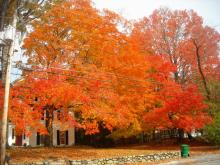
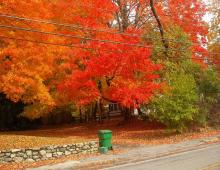
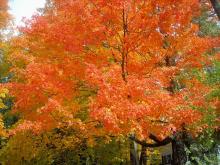
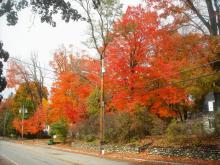
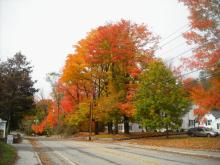
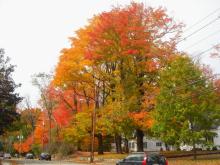
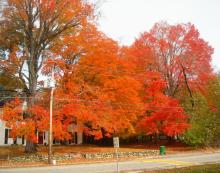
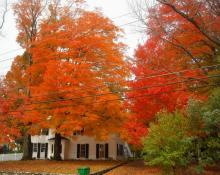
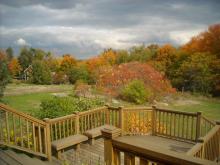
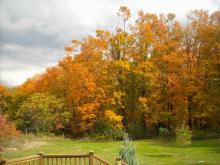

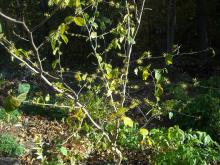




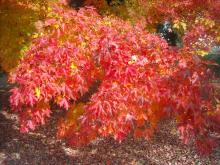


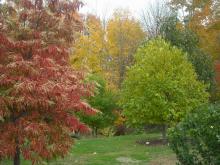
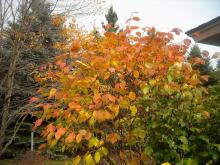
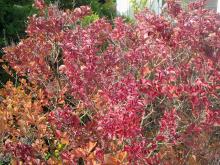
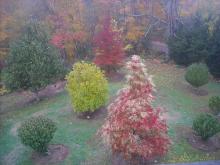
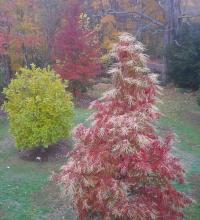
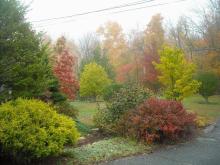




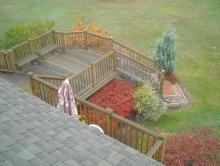
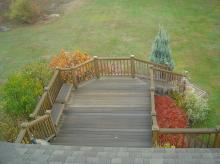
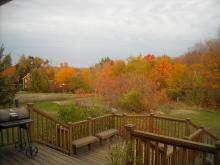
I love to keep leaves on my garden in the winter even here in zone 8. It keeps the weeds down and protects my plants from the frost. My Taro never go all the way dormant under the leaves. Some people say to chip them up so they don't pack down but the last I checked the woods don't have wood chippers ( ;D) but I do rake them up as the plants begin to wake up; however, I put a thick layer down. In France the wild Cyclamen get covered by Oak leaves and they do great.
I cover everything that goes dormant but I usually pile them up and wait till the first frost to spread them since the leaves are falling off now and I usually don't get a killing frost until December. I had to cut down my maple tree this year due to its health. So now I only have a new 15ft Platanus x acerfolia 'Exclamation' in its place so I will have too go and get leaves from my neighbor's yards :(.